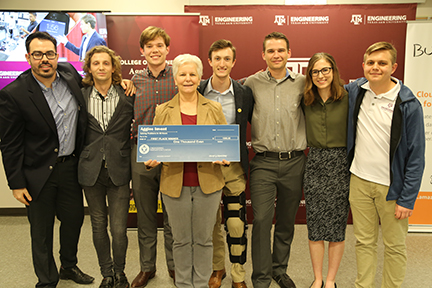
Technology advancement is changing the disability landscape, as demonstrated by the 10 student teams at Aggies Invent for Assistive Technology this past weekend. The 58 participating students were challenged to improve the lives of the more than 57 million Americans who have some form of disability by developing a technological solution to one of the 16 need statements of the competition. This Aggies Invent had students from 18 different majors and ranged from freshmen to graduate students across campus.
“With advancing technology comes new opportunities to address the needs of the larger population,” said Rodney Boehm, director of the Engineering Entrepreneurship Program. “Advances like artificial intelligence and text to speech are evolving so rapidly. We take these cutting-edge technologies and apply them to those who live every day with disabilities.”
Aggies Invent, an intensive design experience offered at the Texas A&M Engineering Innovation Center at Texas A&M University, provides an environment made to inspire and support entrepreneurship and innovative thinking. Students have 48 hours to generate a solution to need statements presented at each Aggies Invent competition. Each event has a completely different theme, keeping the students ready for a challenge.
The solutions presented ranged from translating sign language to text, increasing real-time captioning efficiency and lowering cost, affordable hands-free technology to unlock and open residential doors, and supportive technology for those on the autism spectrum.
 Team Open Sesame won first place in the overall competition. They chose to create a solution to opening doors hands-free. Their functioning prototype used voice commands from a phone to unlatch, open and close the door.
Team Open Sesame won first place in the overall competition. They chose to create a solution to opening doors hands-free. Their functioning prototype used voice commands from a phone to unlatch, open and close the door.
William Smith, a junior manufacturing and mechanical engineering technology major, had heard that doors are the biggest problem for those with disabilities. He had considered each need statement but made his decision when he discovered one about hands-free.
Freshman Robert Myers, who had recently injured his knee in a skiing accident, was drawn to participate in the event because the theme of assistive technology was applicable to his current situation and gave him unique insight into what it’s like to live with a disability.
Team CAPCHA won second place for their fully functional, real-time captioning system as an app. Their inspiration came from personal experience.
“We often saw that when we attended different conferences and events that it is hard to listen to what is going on, especially if you are sitting in the back,” said Shubham Sarwate, a computer engineering graduate student. “We thought, ‘What would happen if a person with a hearing impairment goes to this conference?’”
The team was very passionate about their work and saw a growing interest in mentors as they assisted throughout the weekend.
“If we can bring this to the market, this will not only benefit people with a hearing disability but every one of us,” said Sarwate.
Taking third place was Team Carlisle with YourDay, a task management system for users with cognitive disorders which integrated a wearable monitoring device with AWS cloud software. Unusual for Aggies Invent, an honorable mention award was given to Team Third Eye for their wearable device that vibrates as a person gets closer to a pathway obstruction using camera recognition software.
Mentors assisting throughout the weekend ranged from those with vision impairments to those who work to make accessibility a priority on a daily basis. Debra Dandridge, accessibility coordinator with Texas A&M Engineering Information Technology, guided students using her work background as a resource.
“Technology lends to a more inclusive society,” said Dandridge. “If I went by a group of people using sign language, I can’t understand or engage that group. With some of the technology these groups are proposing, we have overcome that barrier.”
The participants from Team Open Sesame all found value in the competition, and said the prize of the weekend wasn’t a winning idea, but a “winning team” to call on during the rest of their education here at Texas A&M. They recommended every engineering student participate, saying that this is what engineering is all about. Theory is a large part of instruction and coursework, but Aggies Invent allows students to work with a team and see a project come together.
“Aggies Invent is particularly special,” said Michael Bayern, a senior electrical engineering student. “When I was a freshman, I did not know what I wanted to do--I didn't really know who I was--and when I did [Aggies Invent], it just helped me go into the right direction. I feel like experiences like these help you make up your mind and figure out what you're really passionate about.”
The top three teams received $1,000, $750 and $500, respectively. The Engineering Entrepreneurship Program also offers support for students to continue working on their projects, along with a wide range of programs and events that help promote students’ understanding of business principles from an engineering perspective.
Sponsors of the event were Amazon Web Services (AWS), Trane Residential Heating and Air - an Ingersoll Rand Company, Texas A&M Disability Services and IT divisions, and Texas A&M Engineering IT and Accessibility.
“It was incredible to watch students incorporate AWS products and services to build real-world solutions that help individuals with disabilities and address accessibility challenges,” said Andrew Ko, director of global education of Amazon Web Services. “Congratulations to Aggies Invent participants for an extraordinary showcase of entrepreneurship and maker-skills.”